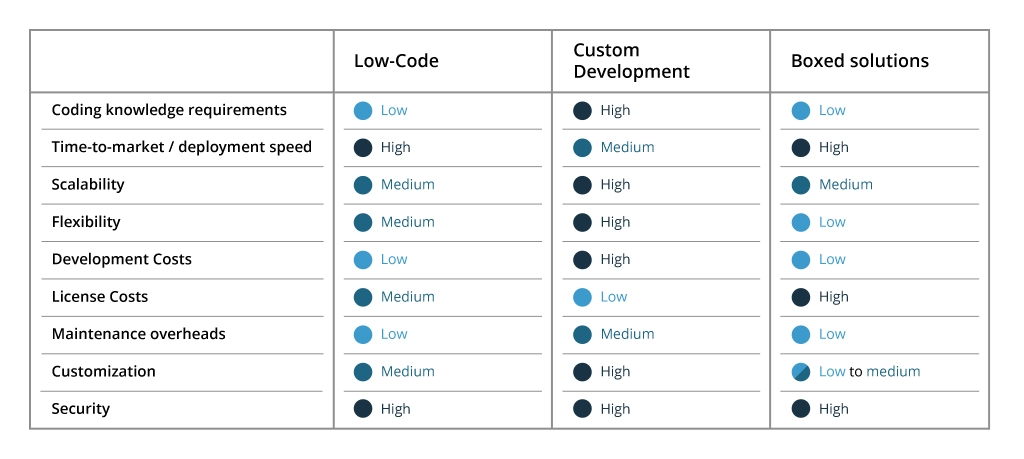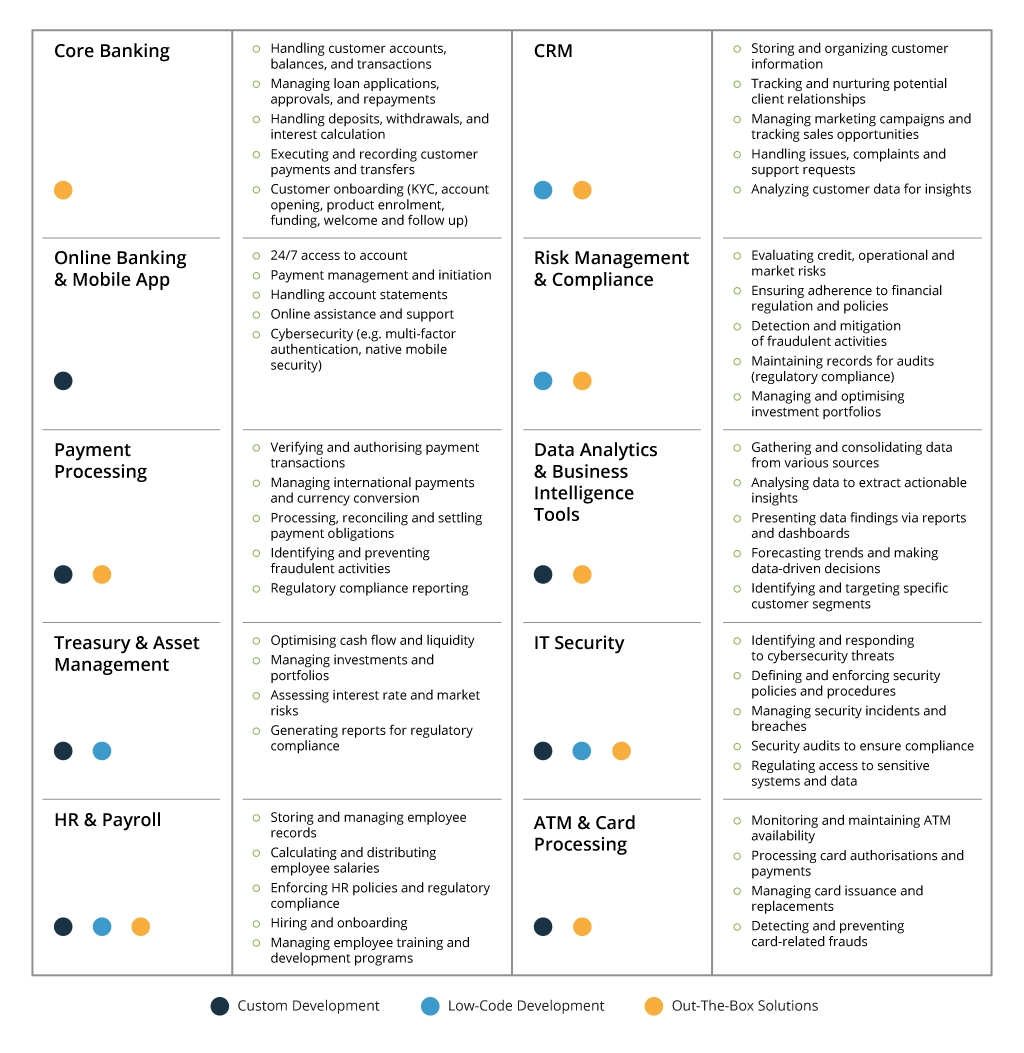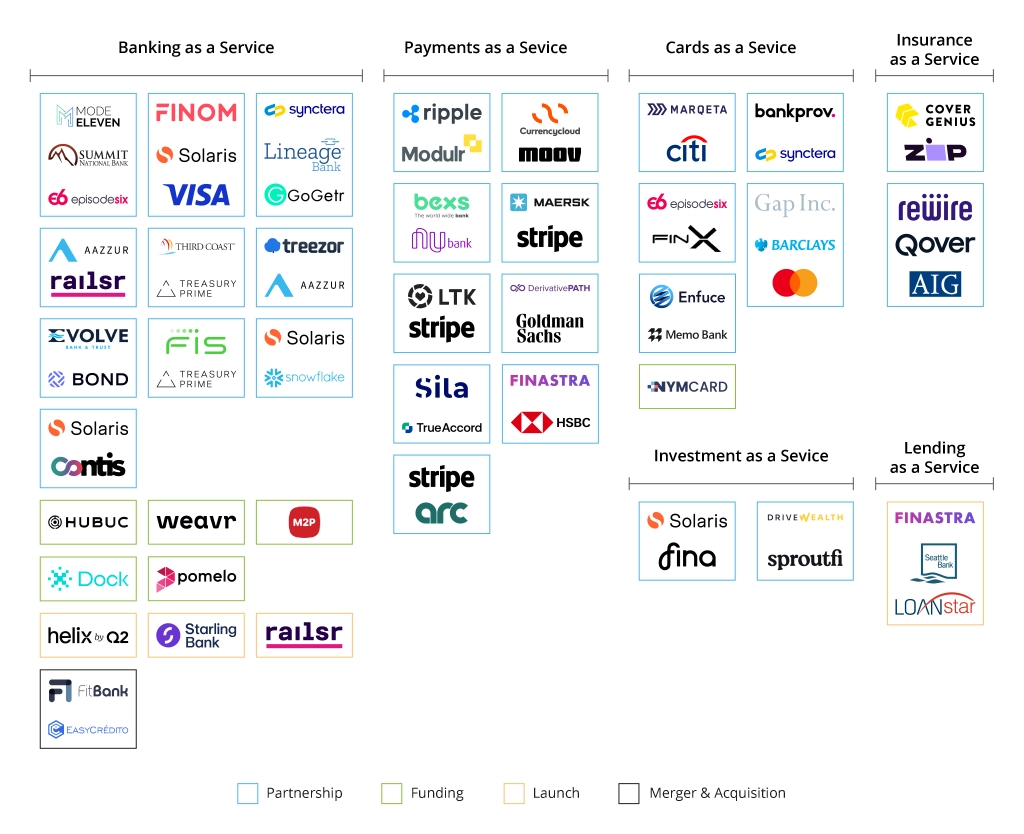Banking Software Development: Out-of-the-Box vs. Custom vs. Low-Code Solutions
In other words: Banking leaders are further elevating digital customer experiences and putting new technologies to use for key business objectives:
- Higher operational efficiencies,
- Increased profitability,
- Reduced risk exposure.
While the ultimate goals are clear, the road towards them is not so straightforward. When deciding on new technology acquisitions and software modernization projects, banking leaders remain pressed with the universal question of whether custom development, no/low-code development, or boxed solutions are the optimal choice.
In this post, we compare the advantages of each approach and elaborate on which approach works best for the different elements of the banking tech portfolio.
Out-The-Box Solutions, Low-Code Development, or Custom Development

Out-Of-The-Box Solutions (IaaS, PaaS, SaaS)
Ready-to-deploy boxed software solutions have been on the market for decades. Cloud computing, however, further commoditized access to new software, drastically reducing the costs of acquiring and operating new technologies.
In the banking sector, cloud technologies have also created a whole new sector of B2B FinTech players, offering access to an array of specialized software, ranging from digital payment processing and wealth management to internal compliance tools, distributed via APIs.
New market entrants can also speed up time-to-market by using banking as a service (BaaS) platforms from mature banks to support core operational processes. In Europe alone, the total addressable market (TAM) for BaaS companies is expected to reach €90-105 billion by 2030.
Competitive costs, coupled with streamlined deployment make out-of-the-box solutions a core element of digital transformation strategies for banks. In fact, 61% of European banks are purchasing SaaS services and/or rely on consultants for implementing new solutions.
Advantages of Boxed Solutions in Banking
- Rapid deployment. Adoption, configuration, and training can take as little as several days to a maximum of several weeks, which is substantially faster than low- or full-code development.
- Cost-efficiency thanks to pay-per-use and other subscription-based models, which eliminate CAPEX costs.
- Banking industry best practices are already incorporated into the product(s), which substantially reduces compliance overheads.
- Continuous access to innovative features, delivered by the vendor and instantly accessible on the current plan or via license updates.
Low-Code Development
The new breed of low-code tools like Power Platform provide an intuitive interface for process automation and simplified digital product development. Business users can use pre-made components and visual drag-and-drop builders to streamline repetitive manual processes, ranging from account reconciliation to employee onboarding. Sample low-code application use cases in banking include automated loan calculators, streamlined loan application management, and various internal audit applications.
Professional developers, in turn, can leverage low-code platforms to create custom integrations between different business systems and flexible automation of multi-step workflows. Also, they can provide new UX components, data sources, and custom business logic elements, which business users can then use in a visual building environment. On average, development teams that use Power Platform achieve a 48% reduction in app development costs, while business teams achieve over $10.2 million in productivity gains due to manual work reduction, according to a Forrester study.
Advantages of Low-Code Development
- Fast development. Substantially reduce the backlog of postponed IT projects by empowering business users and developers with easy-to-use tools.
- Low overheads. One Power Apps license provides access to a set of diverse capabilities for citizen and professional app developers. Thanks to centralized app lifecycle management and embedded security, the “upkeep” tasks are minimal.
- Cross-device ready. Power Apps could be deployed as part of Power Apps app to iOS, Android, Windows or as a standalone app to iOS and Android. This device-agnostic approach allows easily deploying new products across a range of devices.
- Increased business agility. Optimize internal processes to adapt to changes in the market. Improve customer service levels and employee satisfaction by giving your people better tools to do their work.
Custom Development
Although new software is easily available off the shelf, most global corporate banks (61%) still prefer to build some banking systems in-house, namely, cash forecasting solutions, and 72% opt for custom development of payment processing software.
Custom solutions allow banks to maintain full control over strategically important systems and achieve competitive differentiation. Moreover, custom software development makes more sense when the project involves modernizations or customizations of the existing solution, rather than the creation of an entirely new software system.
For example, Infopulse team helped a large Nordic bank modernize its core banking system to improve its performance and maintainability. The bank opted for custom development in this case because fully replacing the platform would have caused major operational disruptions. So based on our initial technology assessment, we found an effective strategy for the iterative splitting of the system, which would separate business logic from a technology platform.
Subsequently, our team has successfully decoupled business domain functionality into new sub-systems, thus enabling independent maintenance and preventing changes in one business logic component from affecting other domains. With the new architecture in place, the bank could also speed up time-to-market for new digital products, without worrying about disruption to downstream systems or integration issues.
Advantages of Custom Development
- Flexibility. Custom solutions are fully adapted to your business processes and operational needs to a degree no boxed solution could possibly deliver.
- Reliability. With full access to source code and underlying IT infrastructure, you remain in full control over the system performance characteristics.
- Limitless possibilities. Expand your services portfolio; deploy distinct functionality and new digital products without any technological constraints.
- Differentiation. Increase your organization’s value through patented intellectual property and unique capabilities that competition cannot fully mimic.
Which Approach to Select? A Reference Decision Matrix

Core Banking
If you are launching a new digital banking solution or expanding the financial market from another sector, out-of-the-box solutions are a solid choice for a core banking system.
The BaaS market is highly mature, with an array of players supplying technical infrastructure for offering financial services such as checking account opening, card issuing, lending, investment, and insurance.
Boxed core banking solutions come with all the essential functionality, built in line with the regulatory policies. This means new entrants can rapidly launch a new product without worrying too much about industry compliance. For example, digital banks Volt and Varo, among others use the Temenos banking cloud platform. N26 and CapitalBox, in turn, went with Mambu’s banking platform.
Overall, boxed SaaS solutions provide an excellent base for new product development and are always further extended and customized with ad-hoc development.
Digital Banking Apps
Online and mobile banking are among the preferred interaction channels by most retail consumers, bringing more revenues to banks. On average, the monthly revenue per customer increased by 10.7% after enrolling in digital banking and digital customers are 35% less likely to leave a bank, a Fiserv study found.
That said, FinTech companies and neobanks have already set a high bar for digital banking experience, forcing traditional banks to play catch-up. Сustom development is therefore the way to go for web and mobile banking app development as it is the best route to ensure:
- Superior user experience (UX) and customer experience (CX)
- Strong product differentiation through advanced features and integrations
- High scalability potential to support a large user base
Payment Processing
The payment processing industry has a number of established players, offering secure, scalable out-of-the-box solutions. Whether you are looking to deploy a digital wallet, support real-time cross-border transactions, or process contactless payments, chances are there is a suitable boxed solution on the market. With some extra customizations and fine-tuning, you can get a compliant system for processing millions of records in real time without spending months on development efforts.
Custom software development can be a better option for payment reconciliation and settlement in case your workflows differ from the industry-wide ones. In some cases, banks can also achieve a greater degree of automation with no and low-code solutions for selected workflows, especially those pertaining to payment reconciliation, various authorizations, and approvals.
ATM and Card Processing
This segment of the financial market is also too complex for low-code platforms. Because of the high transaction volumes and speeds, boxed and custom solutions make the most sense in this case.
Stripe and Arc, offer API-based access to scalable, highly-secure payment processing networks with global reach. Goldman Sachs also launched transaction banking as a service (TxB) in September 2022 — an API-based service, which allows users to send and collect money globally using the bank-supplied payment rails.
Boxed solutions come with a different degree of possibility, opening further opportunities for customization. Effectively, you can “build upon” the provided infrastructure and extend its capabilities to better suit your operating needs.
Treasury and Asset Management
In the corporate and investment banking spaces, treasury and asset management systems belong to the core solutions, often representing the company’s biggest intellectual property. Custom development also allows banks to pursue a wider range of advanced analytics use cases, ranging from quant trading to next-best-action recommendations for portfolio management.
In addition, custom software can be further augmented with machine learning to deliver even greater efficiency in document management. JP Morgan, for example, embedded machine learning into its contract intelligence platform. With the help of algorithms, analysts can extract over 150 relevant attributes from 12,000 annual commercial credit agreements in minutes, saving the bank over 360,000 hours per year in manual work.
That said, modern low-code tools can also add a good degree of value to back-office processes. You can easily automate less complex workflows such as legal proposal management, compliance monitoring, and trade audits with low-code solutions.
HR and Payroll
HR and payroll are areas where any of the three options works well. Out-of-the-box products can perfectly meet all the requirements of smaller financial institutions. A lot of banks rely on Microsoft products such as SharePoint and Teams to run lean internal operations. Infopulse previously helped four European banks develop convenient intranet solutions on SharePoint to unify access to corporate information and facilitate knowledge management.
Microsoft products can be further extended using the Power Platform. Global HR teams use Power Apps for everything from recruiting and onboarding to payroll calculations and expense management. For example, Rabobank has deployed over 2,500 Power Apps and Power Automate solutions for a number of internal processes including an HR bank for reorganizing the bank’s organizational structure. By combining Power App features with a custom Python algorithm, Rabobank’s team achieved a 99.1% candidate placement accuracy and made the information about new roles more accessible to the bank’s workforce.
Customer Relationship Management (CRM)
Few banks opt for custom CRM software development, since excellent choices are available off-the-shelf: Dynamics 365, Salesforce, and Oracle NetSuite among others. Moreover, each of these platforms can be further extended with native and custom integrations.
In fact, Dynamics 365 and Power Platform share the same technological roots and both rely on Microsoft’s Dataverse service. Dynamics 365 provides access to a range of pre-built CRM capabilities, as well as robust workflow automation (based on Power Automate). On average, Dynamics 365 Sales saves each professional over 300 hours of time spent on gathering, analyzing, and reporting on sales data by the third year of usage.
Risk Management and Compliance
Financial institutions spend a great deal of effort on risk and regulatory monitoring. However, the expanded risk radar and the pace of regulatory change are making compliance more challenging.
Globally, 60% of compliance teams spend between 1 and 7 hours per week updating policies and procedures to reflect the latest regulations. Increased compliance pressure translates to higher costs. Over three-quarters of financial companies have seen an increase in compliance expenditure over the past year.
Compliance is a good contender for low-code-driven process automation as such tools allow teams to streamline a good set of processes at a relatively low cost and fast speeds. Custom solutions development is appropriate for more advanced risk management scenarios such as credit risk modeling, stress testing, and market risk analysis. Santander Bank, for example, opted for the custom development of a wholesale risk management solution to ensure that the new system is fully tailored to its operating processes and can function for the next 20 to 30 years without further scalability, integration, or performance bottlenecks.
Out-of-the-box solutions also make sense for use cases such as fraud detection, prevention, and monitoring.
Data Analytics and Business Intelligence (BI)
There are plenty of out-of-the-box solutions for financial analytics and BI that banks can leverage to obtain real-time insights into customer behaviors, market trends, and revenue opportunities. Apart from delivering top-notch analytics, most boxed solutions have built-in compliance with financial industry regulations such as BASEL II and global privacy laws (GDPR, CCPA, etc).
Many of these can be further customized. Open-source OpenRefine is a highly flexible analytics platform for supporting various data science projects. Power BI is a self-service SaaS analytics tool, which can be adapted for a wide range of use cases.
Custom data analytics solutions, in turn, can be created to support more complex analytical workflows and use cases, requiring big data processing. For example, Infopulse helped a Nordic bank build a custom credit analysis engine to support its lending department. Thanks to a custom analytics engine, the bank increased the number of loan approvals without any negative impact on its non-performing loans ratio and achieved a tangible revenue increase.
IT Security
Last, but not least comes cybersecurity. Over the past several years, banks have experienced a new influx of threats, coming from the increased usage of online banking chances, the proliferation of malware, and increased frequency of targeted hacking attempts.
Out-of-the-box security solutions such as Microsoft Sentinel and AWS Security Hub help to establish baseline protection of your IT estate. Low-code tools, in turn, can help streamline a range of security processes in threat monitoring, detection, and response.
Some banks also opt for custom security solutions, especially to patch vulnerabilities in legacy applications or to support those SOC use cases that boxed solutions do not cover.
To Conclude
For decades, the main route for creating digital differentiation for banks was to develop new technology in-house. Cloud computing has commoditized access to software, enabling faster, more cost-effective access to innovation. The quality of banking software, offered by vendors, often exceeds that of the in-house technology that banks have spent years developing.
The evolving tech landscape makes buying software solutions more compelling than building custom ones in many cases. That said, custom software development still plays a major role in instances when banks want to harness revenue growth through tech-led innovation or differentiate through unique customer experiences.
Low-code solutions occupy the “middle-ground”, offering banks the ability to customize, extend, and reconfigure existing proprietary or commercial solutions to better suit their operational needs. With intuitive workflow automation and rapid low-code app development, banks can more effectively streamline a number of supporting, back-office processes to run leaner operations.
![Banking Software Development [Main Banner]](https://www.infopulse.com/uploads/media/banner-1920x528-software-development-out-of-the-box-vs-custom-vs-low-code-solutions.webp)







![Custom Development vs Low-Code [thumbnail]](/uploads/media/thumbnail-280x222-custom-development-vs-low-code.webp)
![Low-code Myths [thumbnail]](/uploads/media/thumbnail-280x222-low-code-platforms-five-myths-uncovered_rpa-adoption.webp)
![SaaS Application Development [thumbnail]](/uploads/media/thumbnail-280x222-how-to-create-a-saas-app-edited.webp)
![SaaS Development Trends [thumbnail]](/uploads/media/saas-development-trends-to-watch-in-2023-and-beyond-454x222.webp)
![Custom Development vs Staff Augmentation [thumbnail]](/uploads/media/5-reasons-to-choose-custom-development-services-over-outstaffing-280x222.webp)
![Low-code for Banking [thumbnail]](/uploads/media/thumbnail-280x222-low-code-benefits-use-cases-banking.webp)
